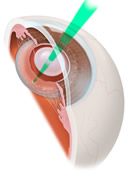 During cataract surgery, your doctor replaces the clouded, blurry area of the lens with an artificial one to correct vision. However, after surgery, many people experience a gradual clouding on the covering of the new lens, a condition known as after cataract or secondary membrane. Clouding is the most common complication of cataract surgery and can cause blurred vision to return, but a solution is available to treat this side effect.
During cataract surgery, your doctor replaces the clouded, blurry area of the lens with an artificial one to correct vision. However, after surgery, many people experience a gradual clouding on the covering of the new lens, a condition known as after cataract or secondary membrane. Clouding is the most common complication of cataract surgery and can cause blurred vision to return, but a solution is available to treat this side effect.
A procedure called a posterior capsulotomy, using an Nd: YAG laser, can be performed to remove the back lining of the lens capsule and let light pass through to the retina. The laser cuts a hole in the back lining and helps remove cloudiness in the lens.
The capsulotomy can be performed in your doctor's office and is a painless procedure that does not require any anesthesia. It is considered a safe procedure and most people only experience short-term increased eye pressure.
A YAG capsulotomy cannot prevent clouding of the lens, but can be beneficial to the 1 in 4 people who experience this complication. It is important to weigh the possible risks and benefits, similar to that of the original cataract surgery, before deciding upon treatment. Most people experience improved vision and reduced glare after undergoing a posterior capsulotomy.
Glaucoma is a leading cause of blindness in the U.S. It occurs when the pressure inside the eye rises, damaging the optic nerve and causing vision loss. The condition often develops over many years without causing pain or other noticeable symptoms - so you may not experience vision loss until the disease has progressed.
Sometimes symptoms do occur. They may include:
People at high risk include those who are over the age of 40, diabetic, near-sighted, African-American, or who have a family history of glaucoma.
To detect glaucoma, your physician will test your visual acuity and visual field as well as the pressure in your eye. Regular eye exams help to monitor the changes in your eyesight and to determine whether you may develop glaucoma.
Once diagnosed, glaucoma can be controlled and further vision loss can be prevented. Treatments to lower pressure in the eye include non-surgical methods such as prescription eye drops and medications, laser therapy, and surgery.
 Ptosis (droopiness) is a common condition that can affect the upper eyelid of one or both eyes as a result of aging, a congenital defect, muscle deformity or neurological disorder. This condition can occur in patients of all ages, but is most common in older patients and will likely continue to worsen with age.
Ptosis (droopiness) is a common condition that can affect the upper eyelid of one or both eyes as a result of aging, a congenital defect, muscle deformity or neurological disorder. This condition can occur in patients of all ages, but is most common in older patients and will likely continue to worsen with age.
In addition to drooping of the eyelids, patients with ptosis may also experience:
Patients may seek treatment for droopy eyelids for cosmetic and/or medical purposes. Severe drooping may obstruct vision as the eyelid gradually droops lower and lower, eventually covering the eye. Other patients are simply bothered by the appearance of their eyelids. Treatment for this condition usually involves eyelid surgery, known as blepharoplasty. This procedure involves lifting the eyelid and reattaching it to a higher location on the face.
Dry eye occurs when the eyes aren't sufficiently moisturized, leading to itching, redness and pain from dry spots on the surface of the eye. The eyes may become dry and irritated because the tear ducts don't produce enough tears, or because the tears themselves have a chemical imbalance.
People usually begin experiencing dry eye symptoms as they age, but the condition can also result from certain medications, conditions or injuries.
Dry eye is not only painful, it can also damage the eye's tissues and impair vision. Fortunately, many treatment options are available.
Non-surgical treatments for dry eye include blinking exercises, increasing humidity at home or work, and use of artificial tears or moisturizing ointment. If these methods fail, small punctal plugs may be inserted in the corners of the eyes to limit tear drainage, or the drainage tubes in the eyes may be surgically closed. Eyelid surgery is also a solution if an eyelid condition is causing your dry eyes.